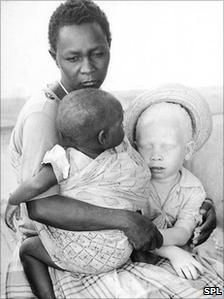Baby tale not black and white
- Published

Albinism is relatively common in parts of Africa
A white baby girl with a mop of blonde hair and blue eyes has been born to black parents living in London. How is this possible?
While there have been several cases of different coloured twins born to parents with mixed-race ancestry in recent years, Ben and Angela Ihegboro, who are originally from Nigeria, say they have no such origins which could explain the phenomenon that is their new daughter Nmachi.
In the case of Nmachi, there are three possible explanations of why she looks so very different from her older brother and sister, who are both black: dormant white genes which entered both of her parents' families long ago, a genetic mutation unique to her, or albinism.
Contrary to reports, doctors at the London hospital where Nmachi was born say they have not ruled out this recessive disorder which affects skin pigmentation.
Mix and match
Like many human traits, a person's colour is influenced by about 12 different genes, which together control the amount of pigment - or melanin - produced in the skin.
It is in principle at least possible that both parents carried light skin gene variants, inherited from unknown white ancestors on either side, which in their cases were masked by dark skin gene variants.
In this way, white parents can also produce a black child, as in the recently filmed biopic of Sandra Laing, the black baby born to Afrikaner parents at the height of apartheid in the mid-1950s.
In Europeans, it is possible - if highly unusual - that African DNA from those who were brought to the continent as Roman slaves joins in two fair parents to produce a dark-skinned child.
Under this theory, when Nmachi was conceived, she inherited both light skin genes which together give her this very fair appearance.
"We are all of us genetic mixtures to some extent and occasionally you'll have a convergence of the pale versions of these genes in African Americans and African Carribbeans who have a mixed black and white ancestry," says Bryan Sykes, Professor of Human Genetics at the University of Oxford.
"But that doesn't seem to be the case here. The parents are Nigerians with little known white ancestry at all."
What is more likely, he says, is a genetic mutation within the little girl herself which she will then pass on to her children if she has any in the future.
Sunburn
But other experts point the finger firmly at albinism, a genetic disorder which in its most extreme form results in a complete lack of pigment in the skin, hair and eyes.
It ranges in severity from Type 1 to 4, with overall about one in 20,000 people born worldwide with some form of the condition.
Both parents could be carrying a copy of the albino gene without it having surfaced in any known family member for many years.
"This is perhaps one of the most common recessive disorders in Nigeria, and we have to remember that it comes in different forms," says Professor Ian Jackson of Human Genetics Unit at the Medical Research Council.
"In Type 2 we would see creamy skin and yellow hair or light brown, which in some cases would darken with age."
The principal health risks of albinism are problems with vision - ranging from the mild to the severe - and sun damage to the skin due to the lack of melanin, which protects against ultraviolet rays.
This is the key problem for those with the disorder in the scorching heat of Africa, potentially less so for a baby born in London - but care will still need to be taken with sunblock and hats.